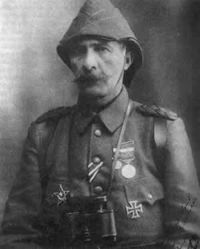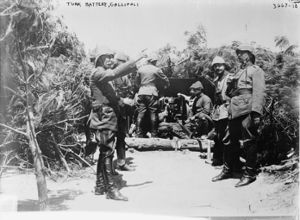محمد أسعد بولكات
محمد أسعد بولكات Mehmet Esat Bülkat | |
|---|---|
 محمد أسعد پاشا في 1915 | |
| ولد | 18 أكتوبر 1862 يانيا، الدولة العثمانية |
| توفي | 2 نوفمبر 1952 (aged 90) اسطنبول، تركيا |
| الولاء | |
| الخدمة/ | |
| سنين الخدمة | 1884–1919 |
| الرتبة | فريق |
| المعارك/الحروب | الحرب التركية اليونانية 1897 حرب البلقان الأولى حملة گاليپولي |
| الأقارب | وهيب پاشا |
محمد أسعد پاشا (Mehmed Esad Pasha ؛ 18 أكتوبر 1862 – 2 نوفمبر 1952)، عـُرِف بإسم محمد أسعد بولكات Mehmet Esat Bülkat بعد قانون لقب العائلة في 1934، كان جنرالاً عثمانياً نشط أثناء حرب البلقان الأولى، حيث قاد فيلق يانيا، وفي الحرب العالمية الأولى، حيث كان قائداً عثمانياً رفيعاً في حملة الدردنيل.
الحياة

وُلِد محمد أسعد في عائلة ألبانية مسلمة في يانيا (التي هي الآن يوانينا) في 18 أكتوبر 1862، ابناً لمحمد أمين افندي، الذي كان عمدة المدينة.[1][2] وحسب جاك كيالوف، فقد كان من أصل ألباني.[1] شقيقه محمد وهيب الألباني (1877–1940)، أصبح أيضاً جنرالاً متميزاً.
Esad spent the first seventeen years of his life in Yanya and later attended the military school at Monastir (modern Bitola).[2] While there Esad's knowledge of Ottoman Turkish was limited and he took additional lessons to broaden his competency in the language.[2] He would reflect later in life that local Muslims of Yanya barely had any knowledge of Turkish.[2] Having polished up his skills in Ottoman Turkish[2] Esad attended the Ottoman Military Academy, graduating in 1884. After a period of service in a regiment, he was selected for the Ottoman Military College in 1887, graduating as a General Staff officer in 1890. His excellent performance led to his immediate dispatch to attend the Prussian War Academy in Berlin, from where he graduated in May 1894.[3] After a stint at the General Staff, he was promoted to Lt Colonel and given a teaching position at the War Academy. By the time the Greco-Turkish War of 1897 broke out, he had been promoted to Colonel, and he commanded a regiment during the war. In 1899, he was placed as head of training at the War Academy. In 1901 he was promoted to Mirliva (Brigadier) and to Ferik (Major General) in 1906. From 1907 he served as Chief of Staff of the Third Army at Thessaloniki.[4]
In 1911, he commanded the 5th Regular (Redif) Division at Gallipoli for a short period before returning to Yanya to command the 23rd Regular Division. It was at this post that the outbreak of the First Balkan War found him.[2] Esat was immediately detached from divisional command and placed in charge of the provisional Yanya Corps, tasked with defending the well-fortified city and the wider region of Epirus. Esad succeeded in defending Yanya for several months against the Greek Army, but was finally forced to capitulate after the Battle of Bizani on 4–6 March 1913.[4][2]
Esat remained in Greek captivity as a prisoner of war until 2 December 1913. His defence of Yanya however had earned him the status of a popular hero, as well as the honorific title of "Pasha". Almost immediately upon his return, on 10 December, he was appointed commander of the III Corps at Gallipoli, which he would lead into battle during the Gallipoli Campaign.[3] The III Corps quickly established itself as one of the most combat-worthy formations in the Ottoman army, as most of its units and soldiers had recent fighting experience from the Balkan Wars. It is indicative that when the Ottoman Army mobilized upon its entry in World War I, Esad's corps was the only one to do so within the prescribed timeframe.[3]
Although most accounts of the Battle of Gallipoli tend to focus on the role of Fifth Army's commander, German general Liman von Sanders, and on Mehmed Esad's subordinate, Mustafa Kemal Pasha (better known as Atatürk, the founder of modern Turkey),[5] it was Mehmed Esad who prepared the Ottoman defences during the battle, and who actively commanded the Ottoman army in the Gallipoli peninsula during the battle.[6][2] In October 1915, Esad was appointed as CO of First Army, succeeding Colmar Freiherr von der Goltz, who was dispatched to the Mesopotamian front. In late 1917, Esad visited Germany and toured the German fronts. In February 1918 he was placed in command of the Fifth Army, and in June, of the Third Army on the Caucasus front. After the Armistice of Mudros, and until his retirement on 22 November 1919, he served as Inspector-General of the mostly demobilized Second Army.
In 1920, Esad Pasha served as Navy Minister in the short-lived cabinet of Hulusi Salih Pasha. In 1934, due to the Surname Law he adopted the name "Bülkat". He died in Istanbul in 1952. A selection of his memories was published in 1975 [7] under the title Esat Paşa'nın Çanakkale Anıları (Esat Pasha's Çanakkale Memoirs).
الهامش
- ^ أ ب Kayaloff p.14
- ^ أ ب ت ث ج ح خ د Gawrych, George (2006). The Crescent and the Eagle: Ottoman rule, Islam and the Albanians, 1874–1913. London: IB Tauris. p. 26. ISBN 9781845112875.
{{cite book}}: Invalid|ref=harv(help) - ^ أ ب ت Erickson (2007), pp. 51–52
- ^ أ ب Erickson (2007), p. 52
- ^ Erickson (2007), pp. 28, 51
- ^ cf. Erickson (2007), pp. 53–54
- ^ "ESAT PASHA (1862–1952)". www.canakkale.gen.tr.
المصادر
- Erickson, Edward J. (2007). Ottoman Army effectiveness in World War I: a comparative study. Taylor & Francis. ISBN 978-0-415-77099-6.
- Kayallof, Jacques (1973). The battle of Sardarabad. Mouton. p. 14. Retrieved 18 October 2011.
- مواليد 1862
- وفيات 1952
- أشخاص من يوانينا
- خريجو الكلية الحربية العثمانية
- خريجو الأكاديمية الحربية العثمانية
- Ottoman people of the Greco-Turkish War (1897)
- جنرالات الجيش العثماني
- پاشوات
- Ottoman military personnel of the Balkan Wars
- أسرى حرب عثمانيون
- Balkan Wars prisoners of war held by Greece
- عسكريون عثمانيون في الحرب العالمية الأولى
- وزراء الدولة العثمانية
- Turkish autobiographers
- مسلمون ألبان
- Zosimaia School alumni
- Burials at Karacaahmet Cemetery
- ألبان الدولة العثمانية
- حملة گاليپولي